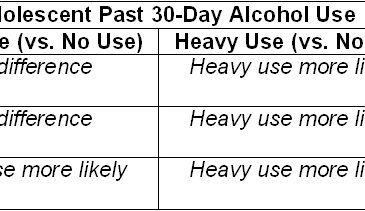According to data from the national Youth Risk Behavior Survey (YRBS), during the 30 days prior to survey, 42% of high school students had at least 1 drink and 24% participated in heavy drinking (Center for Disease Control and Prevention, 2009). Parenting style likely has an effect on adolescent alcohol use. However, researchers have reported conflicting results about the effects of parenting practices, specifically control (i.e., monitoring, discipline) and support (i.e., warmth, nurturance), on adolescent alcohol use (e.g., Dubow, Boxer, & Huesmann, 2008; King & Chassin, 2004). This week’s DRAM reviews a recent article that examined the effect of parenting style (i.e., authoritative, authoritarian, indulgent, and neglectful) on adolescent alcohol use in a large representative sample (Bahr & Hoffmann, 2010).
Methods
- Bahr & Hoffman used a multistage probability sample to select 4,983 students in grades 6-12 to complete the survey.
- The survey included the following variables:
- Dependent variable: Past 30 day alcohol use: no use; light use (i.e., less than five drinks in one sitting); or heavy use (i.e., five or more drinks in one sitting)
- Independent variables: Parenting style: authoritative (i.e., high support, high control), authoritarian (i.e., low support, high control), indulgent (i.e., high support, low control), or neglectful (i.e., low support, low control); Religiosity: 2 items measuring frequency and importance of religion; Peer alcohol use: among four best friends the number who drink.
- The researchers used structural equation modeling (SEM) to estimate the effect of parenting style, religiosity, and peer alcohol use on past 30 day alcohol use.
Results
- Adolescents whose parents were authoritative were less likely to drink heavily than adolescents from the other three parenting styles, and they were less likely to have close friends who used alcohol (see Figure).
- Contrary to expectations, authoritative parenting had no significant effect on light alcohol use compared to authoritarian and indulgent parenting styles, but did have a significant effect compared to neglectful parenting.

Figure. Parenting style and adolescent alcohol use (adapted from Bahr & Hoffman, 2010). Note: Results are from SEM that included adolescent religiousness and the following covariates: age; gender; race; family structure; and parental education. Click image to enlarge.
Limitations
- Barr and Hoffman employed a cross-sectional study design making it impossible to determine cause and effect.
- The authors relied on student self-report, and the results are subject to the biases associated with self-report.
Conclusion
These results support the hypothesis that parental style has a significant but small1 association with the drinking behavior of their adolescent children. These results illustrate how strong parenting styles that include monitoring adolescent behavior and/or strong social support might help deter drinking behavior and insulate adolescents from the peer pressure of heavy drinking. Future research should include longitudinal studies to measure the influence of parenting style on adolescent drinking behavior across time and further refine our understanding of the moderators and mechanisms of that influence, such as parental drinking behavior and the promotion/tolerance of underage drinking.
— John H. Kleschinsky
What do you think? Please use the comment link below to provide feedback on this article.
________________
[1] The effect size for parenting style was smaller (0.08-0.14) compared to peer alcohol use (0.37-0.56).
References
Bahr, S. J., & Hoffmann, J. P. (2010). Parenting style, religiosity, peers, and adolescent heavy drinking. J Stud Alcohol Drugs, 71(4), 539-543.
Center for Disease Control and Prevention. (2009). Trends in the Prevalence of Alcohol Use. Youth Risk Behavior Survey Retrieved July 09, 2010, from http://www.cdc.gov/healthyyouth/yrbs/pdf/us_alcohol_trend_yrbs.pdf
Dubow, E. F., Boxer, P., & Huesmann, L. R. (2008). Childhood and adolescent predictors of early and middle adulthood alcohol use and problem drinking: the Columbia County Longitudinal Study. Addiction, 103 Suppl 1, 36-47.
King, K. M., & Chassin, L. (2004). Mediating and moderated effects of adolescent behavioral undercontrol and parenting in the prediction of drug use disorders in emerging adulthood. Psychology of Addictive Behaviors, 18(3), 239-249.





Mike Dennis July 28, 2010
I have issues any time we ask teens to complete surveys as I think teens tend not to take things seriously and often time are not honest.